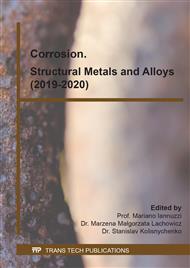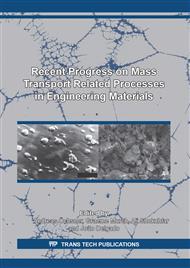[1]
W. Liu, D. Wang, X. Chen, C. Wang, H. Liu, Recurrence plot-based dynamic analysis on electrochemical noise of the evolutive corrosion process, Corros. Sci. 124 (2017) 93–102.
DOI: 10.1016/j.corsci.2017.05.012
Google Scholar
[2]
Y. Hou, C. Aldrich, K. Lepkova, L.L. Machuca, B. Kinsella, Monitoring of carbon steel corrosion by use of electrochemical noise and recurrence quantification analysis, Corros. Sci. 112 (2016) 63–72.
DOI: 10.1016/j.corsci.2016.07.009
Google Scholar
[3]
L. Calabrese, L. Bonaccorsi, M. Galeano, E. Proverbio, D. Di Pietro, F. Cappuccini, Identification of damage evolution during SCC on 17-4 PH stainless steel by combining electrochemical noise and acoustic emission techniques, Corros. Sci. 98 (2015) 573–584.
DOI: 10.1016/j.corsci.2015.05.063
Google Scholar
[4]
P. Casajús, N. Winzer, Electrochemical noise analysis of the corrosion of high-purity Mg-Al alloys, Corros. Sci. 94 (2015) 316–326.
DOI: 10.1016/j.corsci.2015.02.014
Google Scholar
[5]
B.P. Markhali, R. Naderi, M. Mahdavian, M. Sayebani, S.Y. Arman, Electrochemical impedance spectroscopy and electrochemical noise measurements as tools to evaluate corrosion inhibition of azole compounds on stainless steel in acidic media, Corros. Sci. 75 (2013) 269–279.
DOI: 10.1016/j.corsci.2013.06.010
Google Scholar
[6]
S.V. Muniandy, W.X. Chew, C.S. Kan, Multifractal modelling of electrochemical noise in corrosion of carbon steel, Corros. Sci. 53 (2011) 188–200.
DOI: 10.1016/j.corsci.2010.09.005
Google Scholar
[7]
T. Zhang, D. Wang, Y. Shao, G. Meng, F. Wang, A new criterion to determine the critical pitting temperature (CPT) based on electrochemical noise measurement, Corros. Sci. 58 (2012) 202–210.
DOI: 10.1016/j.corsci.2012.01.026
Google Scholar
[8]
J. Kovac, C. Alaux, T.J. Marrow, E. Govekar, A. Legat, Correlations of electrochemical noise, acoustic emission and complementary monitoring techniques during intergranular stress-corrosion cracking of austenitic stainless steel, Corros. Sci. 52 (2010) 2015–(2025).
DOI: 10.1016/j.corsci.2010.02.035
Google Scholar
[9]
A. Aballe, M. Bethencourt, F.J. Botana, M. Marcos, J.M. Sánchez-Amaya, Use of wavelets to study electrochemical noise transients, Electrochim. Acta. 46 (2001) 2353–2361.
DOI: 10.1016/s0013-4686(01)00424-8
Google Scholar
[10]
F.H. Cao, Z. Zhang, J.X. Su, Y.Y. Shi, J.Q. Zhang, Electrochemical noise analysis of LY12-T3 in EXCO solution by discrete wavelet transform technique, Electrochim. Acta. 51 (2006) 1359–1364.
DOI: 10.1016/j.electacta.2005.07.012
Google Scholar
[11]
A.M. Homborg, E.P.M. van Westing, T. Tinga, X. Zhang, P.J. Oonincx, G.M. Ferrari, J.H.W. de Wit, J.M.C. Mol, Novel time-frequency characterization of electrochemical noise data in corrosion studies using Hilbert spectra, Corros. Sci. 66 (2013) 97–110.
DOI: 10.1016/j.corsci.2012.09.007
Google Scholar
[12]
A.M. Homborg, R.A. Cottis, J.M.C. Mol, An integrated approach in the time, frequency and time-frequency domain for the identification of corrosion using electrochemical noise, Electrochim. Acta. 222 (2016) 627–640.
DOI: 10.1016/j.electacta.2016.11.018
Google Scholar
[13]
M.G. Pujar, U. Kamachi Mudali, S.S. Singh, Electrochemical noise studies of the effect of nitrogen on pitting corrosion resistance of high nitrogen austenitic stainless steels, Corros Sci. 53 (2011) 4178–4186.
DOI: 10.1016/j.corsci.2011.08.027
Google Scholar
[14]
Y.J. Tan, N.N. Aung, T. Liu, Novel corrosion experiments using the wire beam electrode. (I) Studying electrochemical noise signatures from localised corrosion processes, Corros. Sci. 48 (2006) 23–38.
DOI: 10.1016/j.corsci.2004.11.019
Google Scholar
[15]
K. Hladky, J.L. Dawson, The measurement of localized corrosion using electrochemical noise, Corros. Sci. 21 (1981) 317–322.
DOI: 10.1016/0010-938x(81)90006-8
Google Scholar
[16]
M.A.M. Ibrahim, S.S. Abd El Rehim, M.M. Hamza, Corrosion behavior of some austenitic stainless steels in chloride environments, Mater. Chem. Phys. 115 (2009) 80–85.
DOI: 10.1016/j.matchemphys.2008.11.016
Google Scholar
[17]
A. Bautista, G. Blanco, F. Velasco, Corrosion behaviour of low-nickel austenitic stainless steels reinforcements: A comparative study in simulated pore solutions, Cem Concr Res 36 (2006) 1922–(1930).
DOI: 10.1016/j.cemconres.2005.10.009
Google Scholar
[18]
F. Bocher, F. Presuel-Moreno, J.R. Scully, Investigation of crevice corrosion of AISI 316 stainless steel compared to Ni–Cr–Mo alloys using coupled multielectrode arrays, J. Electrochem. Soc. 155 (2008) C256–C268.
DOI: 10.1149/1.2883741
Google Scholar
[19]
A. Belfrouh, C. Masson, D. Vouagner, A.M. DE Becdelievre, N.S. Prakash, J.P. Audouardt, The Cumulative Effecy of Alloying Elements N, W, Mo and Cu on the Corrosion Behaviour of 17Cr-13Ni Stainless Steel in 2N H2SO4, Corros. Sci. 38 (1996) 1639–1648.
DOI: 10.1016/s0010-938x(96)00033-9
Google Scholar
[20]
S.A. Salih, A.N. El-Masri, A.M. Baraka, Corrosion behaviour of some stainless steel alloys in molten alkali carbonates (I), J. Mater. Sci. 36 (2001) 2547–2555.
Google Scholar
[21]
S. Mukai, H. Okamoto, T. Kudo, A. Ikeda, Corrosion behavior of 25 Pct duplex stainless steel in CO2-H2S-Cl- Environments, J. Mater. Energy Syst. 5 (1983) 59–66.
DOI: 10.1007/bf02833508
Google Scholar
[22]
R. Kirchheim, B. Heine, H. Fischmeister, S. Hofmann, H. Knote, U. Stolz, The passivity of iron-chromium alloys, Corros. Sci. 29 (1989) 899–917.
DOI: 10.1016/0010-938x(89)90060-7
Google Scholar
[23]
G.M. Bulman, A.C.C. Tseung, The kinetics of the anodic formation of the passive film on stainless steel, Corros. Sci. 12 (1972) 415–432.
DOI: 10.1016/s0010-938x(72)80088-x
Google Scholar
[24]
C.O.A. Olsson, D. Landolt, Passive films on stainless steels - Chemistry, structure and growth, Electrochim. Acta. 48 (2003) 1093–1104.
DOI: 10.1016/s0013-4686(02)00841-1
Google Scholar
[25]
C. Escrivà-Cerdán, E. Blasco-Tamarit, D.M. García-García, J. García-Antón, A. Guenbour, Effect of potential formation on the electrochemical behaviour of a highly alloyed austenitic stainless steel in contaminated phosphoric acid at different temperatures, Electrochim. Acta. 80 (2012) 248–256.
DOI: 10.1016/j.electacta.2012.07.012
Google Scholar
[26]
Y.X. Qiao, Y.G. Zheng, P.C. Okafor, W. Ke, Electrochemical behaviour of high nitrogen bearing stainless steel in acidic chloride solution: Effects of oxygen, acid concentration and surface roughness, Electrochim. Acta. 54 (2009) 2298–2304.
DOI: 10.1016/j.electacta.2008.10.038
Google Scholar
[27]
P. Montes-García, F. Castellanos, J.A. Vásquez-Feijioo, Assesing corrosion risk in reinforced concret using wavelets, Corros. Sci. 52 (2010) 555-561.
DOI: 10.1016/j.corsci.2009.10.014
Google Scholar
[28]
P. Arun, T. Sasikumar, P. Arul Jose, J. Philip, Acoustic emission signal analysis and event extraction through tuned wavelet packet transform and continuous wavelet transform while testing the AA 2219 coupon, Int. J. Acoust. Vibr. 23 (2018) 234-239.
DOI: 10.20855/ijav.2018.23.21447
Google Scholar
[29]
J.C. Goswami, A.K. Chan, Fundamentals of Wavelets – Theory, Algorithms and Applications, John Wiley Sons, New York, (1999).
Google Scholar
[30]
J.M. Lilliy, S.C. Olhede, Generalized Morse Wavelets as a Superfamily of Analystic Wavelets, IEEE Trans. Signal Process. 60 (2012) 6036-6041.
DOI: 10.1109/tsp.2012.2210890
Google Scholar
[31]
M. Mandel, V. Kietov, T. Dubberstein, L. Krüger, The Potentiodynamic Polarisation of a High-Alloy Steel – An Analysis by Acoustic Emission Testing and Long-Distance Microscopy, Electrochim. Acta 240 (2017) 350-360.
DOI: 10.1016/j.electacta.2017.04.091
Google Scholar



